► The best campervans 2024 named
► We round up top options for luxury staycations
► Something for all budgets and styles
During the pandemic, the popularity of campervans exploded, and it’s not so hard to see why. When international travel was plagued with uncertainty, a holiday you can take in the UK with no pre-departure Covid tests, no risk of travel restrictions and a good deal of freedom seemed like the best of all worlds. The appeal of this unrestricted of movement has seen their popularity continue, making the best campervans some of the best cars on sale today.
And these little motorhomes aren’t just useful for going on holiday, either. They make incredibly handy second vehicles – capable of load-lugging with the best of estate cars since they’re essentially very well appointed vans, while some models will double as a practical people-carrier with up to seven seats.
Many owners also use them for sporting pursuits. And they can even serve a useful purpose when parked on the drive – as a spare bedroom or a homeworking office away from the kids.
Best campervans 2024
Whatever you use it for during the week, the best campervans offer the freedom of thousands of campsites at the weekend in the UK alone, with many, many more available to be explored across Europe. And the only real preparation you need to make involves filling the tanks – with fuel and water – checking the gas bottle and grabbing some provisions.
Though expensive to buy, they can last for years and years of happy holidays. And now, you even have a choice of manufacturer-backed campervans – vehicles sold and warranted by major vehicle brands rather than small third-party outfits doing conversions.
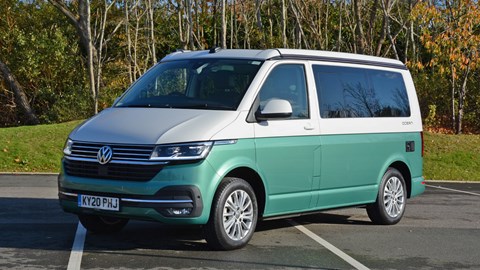
We’ve put two of the best of these – the Volkswagen California (above) and the Ford Transit Custom Nugget – head-to-head below, so scroll down if you want to read that. Or, click here to skip straight past it and read up on the alternatives you might also be considering.
For a more detailed comparison of these two campervans on our sister site, Parkers.co.uk, click here.
Volkswagen California vs Ford Transit Custom Nugget
Both of these vehicles look extremely appealing if you’re hunting for a mid-sized campervan. They’re based on two of the best panel vans you can buy today: Volkswagen’s classy Transporter and Ford’s best-selling Transit Custom. They both sleep a family of four, have pop-up canvas roofs to provide standing room, and offer everything you need to make them your self-contained home away from home.
They both cost around £65,000, though the Volkswagen California Ocean seen here steps that up to £72,000 with several optional extras including a near-£3000 paint job.
But there’s plenty to separate them, and in our eyes – a clear winner, too.
The donor vehicle: an important choice
Though larger campervans are nearly all based on Fiats, in this mid-sized category, the Volkswagen Transporter reigns supreme. There are a variety of reasons for that, but one of the most compelling must be nostalgia – the classic VW Camper is as much an icon as any Beetle or Mini.
Transporters are great to drive, with the latest T6.1 vans featuring technology lifted wholesale from VW’s passenger cars, powerful diesel engines and slick DSG automatic transmissions. They also have a really classy image and feel solidly built. And third-party converters like their high payloads, unobstructed interiors, and strong reliability record.
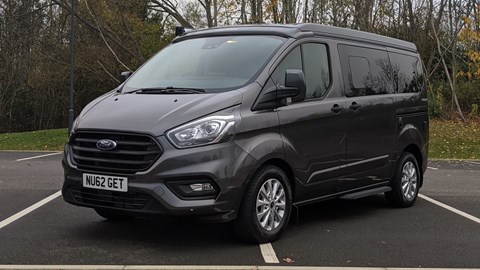
VWs have been converted into campers ever since their introduction, but the California name first appeared on a T3 Transporter-based motorhome in the 1980s. Back then, the duties of conversion went to camping giant Westfalia. But in 2003, VW itself resurrected the name and began building its own Californias in a dedicated factory in Germany.
Range, specs, what to look out for
In an interesting twist of fate, it’s Westfalia that’s responsible for the conversion on the Ford Transit Custom Nugget. Ford has no part in the building of these campers – but like the Volkswagen, you can buy, service and maintain it at a main Ford dealer and it benefits from a full manufacturer warranty on both the base vehicle and the conversion.
The Transit Custom makes a brilliant base vehicle, too. This is the best-selling van in the UK for a reason – it’s great to drive, hugely versatile and so ubiquitous that maintenance is cheap and easy.
Both vehicles are offered with a pair of engine choices. For the Ford, it’s a 2.0-litre diesel with either 128bhp or 183bhp, the latter paired to a six-speed automatic gearbox. The VW also has a 2.0-litre diesel, offered with 148bhp or 197bhp. All Ocean models have a seven-speed DSG automatic, and four-wheel drive is optional.
It’s the Transit that’s the better steer here, though VW’s automatic gearbox is slicker and its diesel engine more efficient. Really, though, there’s little to separate the two beyond personal preference. There’s more to moan on the equipment front, though, as the California Ocean trounces the Transit when it comes to in-cab comforts – boasting climate control, LED headlights and a fully digital dashboard. Not things that matter to your average van driver, but when you’re spending thousands on a home away from home…
What are these campers like inside?
These two vans use totally different layouts. The California’s the more traditional of the two – it has a side-mounted furniture unit, rear-hinged rising roof, and a rock’n’roll bed downstairs. The majority of campervans of this size use this layout, and for good reason, as it’s simple and versatile.
Two can sleep up top in the electrically-operated roof and two below, while there are four belted travel seats. Along the side kitchen unit you’ll find the facilities – a sink with hot and cold running water, a twin-burner gas hob (fed by a gas cylinder in the rear) and a top-loading fridge.
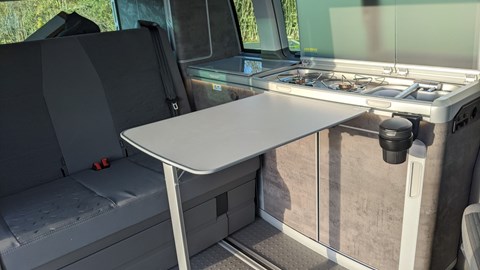
Behind the rear bed there’s a wardrobe and a ‘boot’ area of sorts – this is great if you’re using the California as a secondary car, or for storing suitcases and bed linens when on the move.
The Nugget’s totally different. Its kitchen is L-shaped, and situated at the rear of the van – with a front-hinged roof providing standing room around the sink, twin gas burners and top-loading fridge.
The rear seat – this time a bench for three – sits ahead of this, closer to the two front seats. It makes up into a bed, though not in as intuitive a way as the California’s. The top beds of both vans are very similar, though.
Okay – so what are these campervans to live with?
Which layout you like best is a matter of personal preference. We prefer the California’s traditional layout – it’s more versatile, feels more spacious and that ‘boot’ area is super useful. However, others have pointed out that the Nugget’s more split personality can be beneficial. One parent can cook in the rear of the van while another entertains the kids in the front, for example.
The Ford’s twin sliding doors and three-seat rear bench make it more useful as a people-mover, too, though it’s worth noting it’ll still only sleep four. The California can be optioned with a third rear seat as a separate unit, but it’s an expensive and awkward addition.
No, what really sets these two vans apart is the quality and usability of their interior conversions, and it’s something that a few minutes with either van will display. The Volkswagen California’s interior is a model of clarity, quality and ease-of-use, and the Ford Transit Custom Nugget’s feels awkward and clunky in comparison.
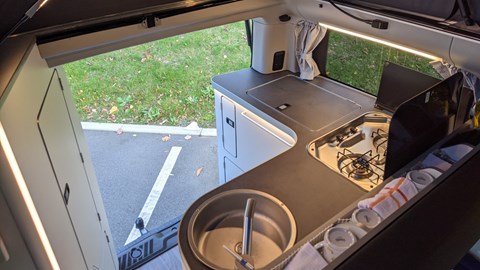
Take something as simple as folding out the downstairs bed, for example. In the California, it’s a three-step process – drop the rear headrests at the touch of a button, slide the seat forward, and drop its backrest down flat. In the Nugget, that process takes twice as long, uses incredibly stiff and uncomfortable levers, and is very difficult to do without stepping out of the van – not ideal if you’re pitching on a cold or rainy night.
Then there are the little things. Who’d’ve thought curtains would be such a problem? The Nugget has them on every window, fastened with desperately fiddly popper buttons. By the time you’ve closed one, you could easily have dropped all of the California’s one-handed roller blinds. The same goes for the front windows, where the California has magnetic blinds that fasten in an instant while the Ford has insulated screens held on by suction cups. Or barely held on, in our case – we stepped down from the top bed in the morning to find they’d fallen off in the night.
These issues may not be big deals to you, and given that both of these vans are available to eye up, poke around and experience in main dealers means you can make a totally educated decision. For our money, though, it’s the California all day long. To save cash we’d sack off the options our test van came with (though it’d be hard to skip the £2880 two-tone paint job…) and opt for the lower-powered 150hp engine, which is still far from sluggish.
The resulting van would be effortlessly competent and beautifully built, with residual values most cars could only dream of. It’s easy to dismiss the California, and vans like it, as expensive toys – but the memories you could make in a decade of stress-free ownership would be priceless.
New models of both these favourites are coming soon
It’s worth noting at this point that both the VW California and the Ford Transit Custom Nugget will be replaced by all-model models before the end of 2024. And the changes are more interesting than you might expect.
Firstly, the new Volkswagen California is no longer based on a van. Instead it transfers to the Multivan MPV, which uses a car-technology platform. Among the things that change as a result is that the next California will have twin sliding doors. We’ve seen the new model ahead of its launch, and it’s impressive.
The new Ford Nugget, meanwhile, uses the second-generation Transit Custom platform, and deploys a similar layout with all the same strengths and weaknesses as the current version. What makes this intriguing is that the next-generation VW Transporter is also a variant of the new Transit Custom…
So perhaps no wonder VW has shifted one of the jewels in its crown to the Multivan, a vehicle it has always labelled the T7 – and therefore the true successor to the T6. There are also ambitions to build an ID. California based on the ID. Buzz, but there are persistent rumours VW is struggling to make it work.
That despite some third parties all carrying out ID. Buzz campervan conversions.
What are the alternatives? We name the best campervans of 2024
Mercedes-Benz Marco Polo
The premium choice

Don’t fancy a Ford or a VW? There’s one other campervan sold in the UK with the full backing of its base vehicle manufacturer – the Mercedes-Benz Marco Polo. And we’ve driven the version that’s just been updated for 2024. It’s as luxurious as any vehicle carrying that three-pointed star, based on the V-Class people-carrier, fitted with a 233bhp diesel engines and comes with a smooth nine-speed automatic.
Fit and finish is a step above the California – and way beyond the Nugget – but with a line-up now reduced to the most powerful engine and a single trim level (plus an AMG Line styling package, if you want it), the Marco Polo comes at a considerably higher price. You’ll also want to budget a little extra for the nvel new air-suspension, which can automatically level the van on a bumpy camping ground. It’s superb.
Volkswagen Grand California
We like big bus and we cannot lie

If space is your concern – you want more of it on the inside and don’t mind how much you take up on the outside – then look at the Grand California. This is based on the Volkswagen Crafter, itself a brilliant large panel van, and takes everything we enjoy about the regular California and scales it up. So now not only do you get four seats and a kitchen, but you get a permanent bed at the rear, standing room throughout, and best of all – a wetroom with shower and toilet.
The conversion inside is all Volkswagen’s work, and the quality is, of course, spectacular. Though it’s more pricey and less practical as a daily drive than the standard California, this really is a true home-away-from-home, and one we rate very highly.
Volkswagen Caddy California
Awww, cute
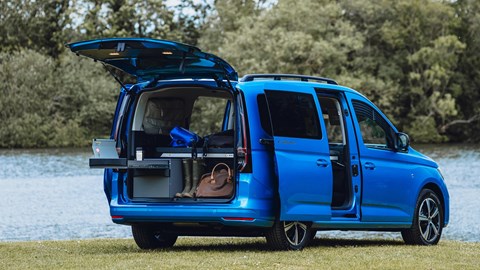
You can scale your VW campers up into a Grand Cali, but you can also scale down. The Caddy California is a marvel of packaging – it’s the size of a family car (and could even be used as one) but features a large double bed and even a kitchen round the rear.
It’s more aimed at day trippers and quick overnight stays than it is at those doing a week-long vacation, but an optional drive-away awning turns it from somewhere just to sleep and eat into a real base of operations. We’ve not had the chance to stay overnight in this one yet, but we’ve driven it and had a good poke around. It’s smaller, but cheaper, and might work for you.
Vauxhall Vivaro Elite
Ford’s big rival also wants in on the campervan pie
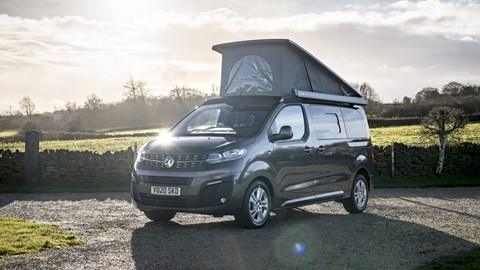
Another one we’ve not had the chance to test yet, this is a conversion by Yorkshire-based Wellhouse Leisure that’s been approved by Vauxhall – so, like the Marco Polo and Nugget, consider it ‘manufacturer-supported’. Wellhouse is well regarded for its camper conversions and the Vivaro looks intriguing – nothing groundbreaking, but solid and attractive.
The Vivaro’s also a really good van to drive, and a little more compact than the Ford, Mercedes or VW siblings. As soon as we’re able we’ll get our hands on one and give it the full going-over.
Toyota Proace Matino
10-year warranty? Sounds good to us
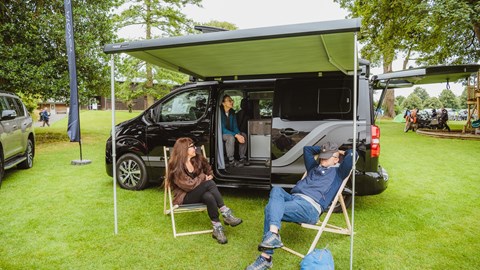
Like the Vauxhall above, this is a Wellhouse Leisure conversion – and since the Proace is functionally identical to the Vivaro these vans are essentially the same. However, with a Toyota you benefit from up to 10 years of warranty cover on the base vehicle.
Third-party conversions
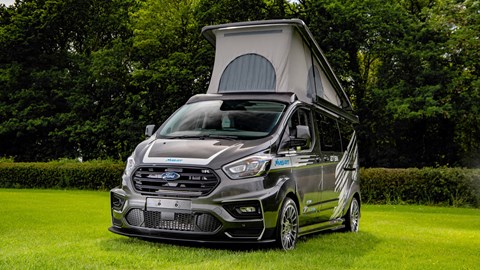
Just because you can buy a campervan from a main dealer, doesn’t mean you have to. The UK is littered with motorhome dealers who’ll sell you any number of third-party conversions – vehicles that hail from all across Europe and come in a dizzying array of specs and layouts.
If you have specialist needs, a third-party conversion is the way to go, as you’ve so much more choice. It’s even possible to spec your own from the ground up, ideally suiting it to your own needs. If you need extra seats, or wheelchair accessibility; if you want a bigger kitchen, or a longer bed or a wine cooler or crocodile-skin upholstery – there’s a converter out there for you.
Some even specialise in campervans built on used base vehicles, helping to bring the price down to a level that might be more manageable.